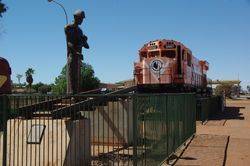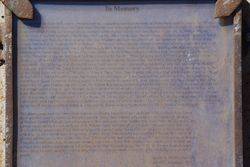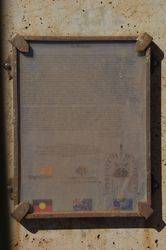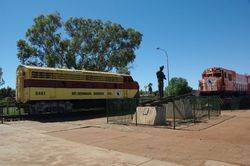
Home » Themes » Culture » Indigenous
Torres Strait Islanders & Pilbara Iron OrePrint Page 
In 1968, a rail gang of Torres Strait Islanders broke the world record for track-laying while working on the Mount Newman line, sinking 7 kilometres of track in 11 hours and 40 minutes. Torres Strait Islanders left a legacy of more than 2000 kilometres of track winding around the Pilbara, and the statue is the first monument to their contributions.
While few Australians are aware of this historic event, within the Torres Strait Islander community the track-laying record is well remembered and celebrated. Stories are passed down to family members through anecdotes and songs, with memories triggered by precious photographs and mementoes.
Location
| Address: | Wilson Street, Don Rhodes Mining Museum, Port Hedland, 6721 |
|---|---|
| State: | WA |
| Area: | AUS |
| GPS Coordinates: | Lat: -20.311657 Long: 118.605331 Note: GPS Coordinates are approximate. |
Details
| Monument Type: | Sculpture |
|---|---|
| Monument Theme: | Culture |
| Sub-Theme: | Indigenous |
| Artist: | Antonio Battistessa |
Dedication
| Approx. Monument Dedication Date: | 2005 |
|---|
In Memory
This memorial has been dedicated to commemorate the oustanding contributions made by Torres Strait Islander men to the Pilbara Iron Ore Industry. In the 1960s, over 700 Torres Strait Islander men were employed by the railway construction companies to work in the harsh conditions of the Pilbara and to construct the southern standard gauge railway line from Perth to Kalgoorlie. In 1968, during construction of the Port Hedland to Mt Newman railway line, Morrison-Knudsen-Mannix-Oman (MKMO) recruited a group of Torres Strait Islander men from Darwin to team up with other Islanders who were transferred from Hamersley Iron Ore Company railway in the Pilbara construction to construct the Port Hedland- Mt Newman railway project.
Other Torres Strait Islanders made their way north from the southern standard gauge line from Perth to Kalgoorlie to work on this construction. Working with other contractors they constructed in record time, over 400km iron ore railway track from Port Hedland to Mt Newman. According to John Kennell (Snr) an elder Torres Strait Islander and former back steel foreman for MKMO "250 miles of rail track (or) railway line were laid from Port Hedland to Mt Newman, 1968 to 1969 was laid in ten months complete" (Kennell Snr Dec 2005). During the final stages of the construction, the rail laying crew of about 70 Torres Strait Islander men with a small group of other men were asked by MKMO managerial staff if they, the Torres Strait Islander rail crew, could break the current world record of track laying which was set in 1962 by two MKMO staff foremen Mr. Patrick Levi (Deceased) from steel gang and Mr John Kennell Snr., back steel gang.
According to Island Custom by showing respect to their islander foremen and by sheer determination they were timed by MKMO to commence the record broken feat at 6.10am. By 5.50pm they had approximately (AREA PASTING) laid, spiked and anchored 23,760 feet of track and in doing so gave Australia claim to the new world record by laying 4.5miles (7.5km) of rail track in the time of 11 hours 40 minutes. The volume of the materials used by the Torres Strait Islander men to accomplish this feat was approximately 896 tons of (136lbs) rail, 11,880 sleepers (2.7mx30cm), 23, 760 rail plates, 47,280 rail anchors, 4,280 dog spikes, many tons of track ballast (blue metal) and the instalment of numerous fish plates and bolts to link the 7.5km tracks with the main line. This world laying record was accomplished on May 8, 1968 and the Australian track record has since remained unchallenged.
(Excerpt from Inscription) George H. Pitt (MA Soc Sci)
KNISIC, December 2005








